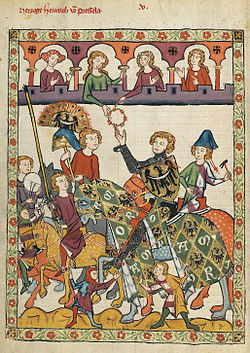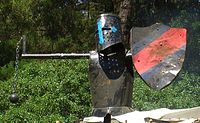Hastilude
For example, in 14th century Germany, distinction was made between the Hohenzeuggestech, where the aim was to break the lance, and the Scharfrennen, where knights sought to unhorse their opponents.
That it was seen as a separate event, with its own rules and customs, is clear from historical documents such as Edward II of England's 1309 ban of all forms of hastilude except the joust.
By the nature of its duel, and the discrete space required for the action, the joust became a popular spectator and ceremonial sport, with elaborate rituals developing around the whole event.
Behourd, buhurt and mêlée (the latter term being modern) refer to a class of hastiludes that involve groups of fighters simulating cavalry combat.
While frequently referred to by contemporary sources, and included (separately) in various prohibitions and declarations over the medieval period, little is known about the nature of the tupinaire.

